Rock cutting is an art form that requires a high level of skill and patience. It can be difficult to cut through the hardest stones, but when done correctly, it can produce amazing results. In this article, you will learn how to take on rock cutting with confidence by learning about the different types of the best lapidary saws there are and what they are used for as well as tips for successful rock cutting.
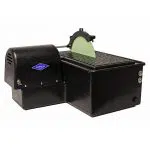
Best lapidary saws on the market
| Image | Product | |
|---|---|---|
Best Choice  | Hi-Tech Diamond 10" Lapidary Slab Saw
| Check Price |
Best Lapidary Trim Saw 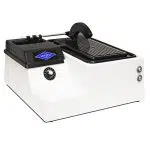 | Hi-Tech Diamond 6" Lapidary Trim Saw
| Check Price |
Best Mini Trim Saw 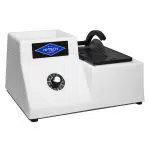 | Hi-Tech Diamond 4"/5" Lapidary Trim Saw
| Check Price |
Best Hobby Rock Cutting Saw 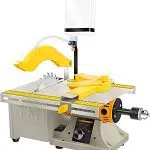 | LIBAOTML Mini Table Saw for Hobbies
| Check Price |
Other Worthy Mention 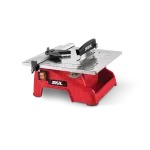 | SKIL 3540-02 7-Inch Wet Tile Saw
| Check Price |
Best Products
Best Lapidary Slab Saw – Hi-Tech Diamond 10″ Lapidary Slab Saw
The Hi-Tech Diamond 10″ Lapidary Slab Saw is a really great saw that works smoothly and efficiently. Whether you want a small gemstone or a large countertop, the saw has the power to do it all. All of this is possible with its powerful 1/3 hp motor, which can cut quickly through just about anything! In addition to being super strong, it’s also really quiet so as not to upset your neighbors. With its versatility and power these features make working on projects using this tool easier than ever before!
We recommend getting some vise clamps too so you can safely sharpen them without risk of injury or harm. The carriage and parts that hold rocks won’t last long but they are cheap to replace.
Pros:
- The motor runs great and strong
- The saw is quiet
- It uses water instead of oil
- The saw has a decent depth ofcut and cuts well enough
- It is easy to store in a closet and pull out and set up on a table wherever you want.
Cons:
- The carriage and parts that hold rocks won’t last long but they are cheap to replace
- Plastic lid base
Best Lapidary Trim Saw – Hi-Tech Diamond 6″ Lapidary Trim Saw
Sometimes you want to create a work of art, or make something from scratch. Well, look no further! The Hi-Tech Diamond 6″ Lapidary Trim Saw is the perfect saw for beginners in lapidary to get started with! It comes well made, solid, and easy to use – whether you need it for cutting stone or trimming. The one thing that stands out about this machine is its stability.
This product comes with a blade attachment that is functionally limited and shoddy. You have to dispose the dirty water out of the machine by hand, which exponentially increases the risk of a mess. The saw is not cheap.
Pros:
- This is a great saw for a beginner in Lapidary materials.
- Super easy to set up.
- Well made and solid.
- Very simple to use, consistent, and easy to clean.
- Very stable machine.
Cons
- Too messy to dump out the dirty water.
- The blade the the machine comes with only lasted a couple of cuts.
- Expensive.
Best Mini Trim Saw – Hi-Tech Diamond 4″/5″ Lapidary Trim Saw
It’s small enough to comfortably cut down your material, but not too small for all of your needs. You’ll love that it can cut away any imperfections or chips to reveal the perfect gemstone underneath. The diamond wheel is thin so little material is lost. It also uses water as a lubricant which means less mess! The black plastic top has no glare so even in low-light conditions you won’t have trouble seeing what you are doing, and the blade is easy to access and change if needed. And last, but not least there’s an easy way to rinse out this saw!
Pay attention that the plastic work area will scratch and gouge with any sharp material, the splash shield is way too close to the blade.
This machine is not cheap.
Pros:
- The diamond wheel is very thin so little material is lost
- It uses water as a lubricant
- The saw has a black plastic top that has no glare
- The blade is easy to access and change
- Easy to rinse out
Cons:
- The plastic work area will scratch and gouge with any sharp material
- The splash shield is way too close to the blade
- The lid is not designed to channel the water into the well again
Other Worthy Mention – SKIL 3540-02 7-Inch Wet Tile Saw
This little saw should do the job for small cutting jobs, like tiles. It’s inexpensive and easy to take out on site with you- it’s not made of metal either, which is great because you’ll never have to be worried about denting it or getting rust all over everything. The extension arm is one place where they cut costs a bit by using plastic but rest assured it does the trick just fine without breaking so no complaints there.
The machine is also really easy to clean- both outside and inside! You can plug it in right near your work area without having to worry about an outlet, too- just flip that switch up at the top for power!
The blade that came with the SKIL is not durable, and you can’t cut much tile before it’s completely dulled. The water reservoir is also small, which means you’ll have to downtime often if you want to cut any large materials. The saw slightly shifts around over time while working.
Pros:
- This little saw fit the bill, inexpensive and small
- The plastic body is very strong
- The extension arm is plastic, but it is sturdy and does the job well
- The unit is easy to clean
- The machine is very portable
Cons:
- The blade that came with the saw will not last long
- The water reservoir was too small
- The saw slightly shifts around over time
What is a lapidary saw and what does it do
What is a lapidary saw and what does it do? A Lapidary Saw, or cutting saw, is used to cut stones into flat pieces for polishing. The blade of the saw can be made from either steel or diamond dust impregnated with resin. Diamond blades are more expensive but last much longer than steel blades which need replacing every few months depending on usage and type of stone being cut. They work in concert with various types of sandpaper and buffing machines as well as grinders such as pedestal grinders to finish the polished product.
Types of Lapidary Saws
There are many different types of lapidary saws available today that range from small hobbyist versions to large industrial ones. Their purpose is the same, but the type of stone they are designed to work with and their size varies.
- Lapidary band saws are the most common type of lapidary saw. They are used to cut straight lines and can be used to create shapes and patterns. Band saws are available in a variety of sizes, so you can choose one that is best suited for your project.
- The ring saw. Ring saws are used to cut curves and circles. They are also available in a variety of sizes, so you can choose one that is best suited for your project.
- The diamond saw. Diamond saws are used to cut hard materials, such as diamonds and other gemstones.
- Lapidary wet saws are also available, which are used to cut material that is wet or difficult to cut. Wet saws are available in a variety of sizes and can be used to create shapes and patterns.
- Hobbyist lapidary saws. These are smaller saws that can be used by beginners for small projects or as a way to polish jewelry stones. They will have a much shorter blade length than professional ones which allows you more control over your cuts. They also only weigh about ten pounds so they’re easy to use if traveling to classes or workshops.
- Professional Lapidary Saws. This is where the large industrial version falls into this category because these types of tools allow for larger pieces of stone (upwards of 200 lbs) along with faster cutting speeds and longer blades up to 36 inches long! With all those benefits they can be used in more industrial environments such as cutting slabs of stone for flooring or tile.
Which type of Lapidary Saw is best for you
Which type of Lapidary Saw is best for you? It depends on what kind of stones you are working with and your budget to get the most out of it. A hobbyist lapidary saw can still cut through a lot of materials but not at the speed that professional ones can which makes them much better suited for big projects. If traveling frequently, then consider getting a smaller lighter version so that it’s easier to pack up and carry around throughout class or workshops too!
How to use your lapidary saw
There are several steps involved when using any type of lapidary saw including feeding material into it, holding the stone during the cut, and finally finishing the stone with a grinder.
- Feeding material into it: This is done by moving your arm up and down to make sure that there are no clumps in the blade at any time during cutting. It can be difficult so we recommend using gloves or some other type of protection for your hands when doing this because it’s easy to get them pinched if you’re not careful!
- Holding The Stone During Cutting: When holding stones while they’re being sawed, wrap one hand around the top edge (either side) of the stone facing away from you about an inch below where you will start cutting and use your thumb on that same edge as leverage to push against your fingers which will help you to get the result. The other hand should be on the opposite side of the stone and pressing it against your first hand.
- Finish The Stone With A Grinder: The last step is to use a grinder or some type of buffing machine like an orbital sander, sandpaper, polisher or buffer to give you that high polish look for a finished product.
Common mistakes made when using a Lapidary Saw
One common mistake made when using any lapidary saw is not feeding material into the blade which can cause clumps in them during the cutting process as well as produce poorer quality cuts. Another error made could be clamping down too hard with either hand while holding rock so that it’s impossible to control cut lines resulting in frustrating patterns that will spoil the material. Finally, not using a grinder or other type of buffing machine to polish the stone after cutting can result in a rough unfinished product that’s too hard to use.
FAQs
Size Of The Saw
The size of the device determines the size of stone that it can cut. - Hobbyist Lapidary Saws: These types of tools are smaller, lightweight lapidary saws usually only used by beginners for small projects like polishing jewelry stones but they also have professional versions as well depending on what you're working with such as cutting slabs of stone or tile in a job site environment. - Professional Lapidary Saw: This type of tool requires a good amount of maintenance, they are heavier and have a slower cutting rate but the reason why you might want one is if your project calls for sawing stones that weigh more than 500 lbs or larger materials like slabs.
Weight Of The Device
The weight of the device must be taken into consideration when choosing what type of tool you're going to buy. The heavier it is, the stronger and more stable it will be for cutting through materials that are larger in size or weight.
Blade Dimensions
A thin blade can make intricate cuts whereas thicker blades are for cutting through materials that weigh more or require a stronger blade. - A thinner blade is better to use if you need finer detail like when making small cuts with jewelry stones but it's not as stable so the heavier duty tools will be much easier to control and have less risk of breaking which makes them perfect for larger projects such as slabs of stone or tile in a job site environment. - Thicker blades can cut smoother surfaces, they're also used by beginners because they do not produce sharp edges on the material being sawed which means there won't be any waste left over after cutting either something else that beginner lapidary saws struggle with sometimes!
Motor Speeds
Faster isn’t always better! - A saw with a faster motor will need to be fed more often because it can burn out the blade quicker. It's also harder for beginners and professionals alike to control, which is why slower speeds are best when you're just starting out or if you're doing a smaller project like jewelry stones. - Professionals might want something that has variable speed so they have options depending on what materials they’re cutting through such as slabs of stone versus tile in a job site environment where there needs to be a slower feed rate due to heavier weight and sturdier design of the tool. The one downside is these types of tools cost much more!
Feeding A Saw
When selecting and operating a saw, the size, weight, and blade measurements are important to consider. For example, if you're using a smaller saw for small projects then your motor speeds will not need to be as high but stabilizing it on the ground before cutting is typically more difficult because of its lightweight. If you're looking at heavier duty saws with motors that cut faster, then stability becomes less of an issue when working with them because they have enough weight to stay in place when being used so long as there's sufficient room around where you'll be operating it. The blade dimensions also come into play with how big or small the material can be cut by the machine which is why some blades may only go up to 12 inches while others might exceed 36 inches depending on what types
Holding the Stone
Hold the stone against the table before cutting by placing one hand on either side of the stone, about an inch below where you will start sawing. The other hand should be pressing against your first to stabilize it.
When a Stone is Too Big
If the stone is too big and you're not using the right tool for cutting it, then just start from one side and cut as much of the stone away that way. This gives you a better chance at being able to get through all material without having to make multiple cuts or take more time than necessary when making this type of mistake. If you end up trimming lots of rough on a lapidary saw blade before starting your project but don't want to ruin either piece with too many facets then try cutting into slabs instead by going perpendicular across rock width (horizontal) so that both pieces are still usable even if they have a less finished product.
Tips on how to care for your lapidary saw
- Clean your lapidary saw with a brush or cloth as you would any other tool that becomes dirty.
- Always wear gloves when handling the blade to avoid cuts and abrasions on the hands
- Store in a dry location away from extreme
Lubricating Your Saw
- When you are not using your saw for a while it’s always best to lubricate the blade, gears, and other moving parts before storage. This is done by spraying or applying some type of oil such as WD40 onto all appropriate surfaces which can be wiped off with cloth afterward.
- The next step is to store your lapidary saw in an area that will keep everything clean including blades, tools, and work surface around them so there isn’t any debris left behind when they’re set aside until you need to use them again!
Cleaning Your Saw
- Clean your lapidary saw with a brush or cloth as you would any other tool that becomes dirty.
- Always wear gloves when handling the blade to avoid cuts and abrasions on the hands
- Store in a dry location away from extreme temperatures so it doesn’t rust over time!
Conclusion
If you’re in the market for a lapidary saw, there are many great options out there to choose from. This article will introduce you to some of our favorites and help you find one that fits your needs. Check it out!
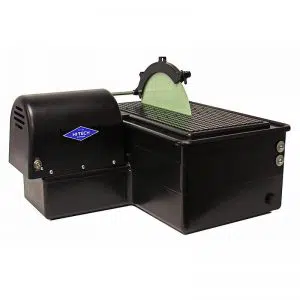
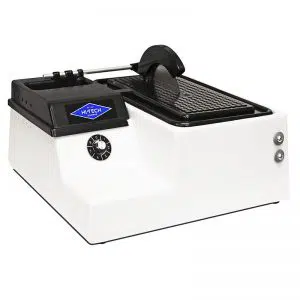
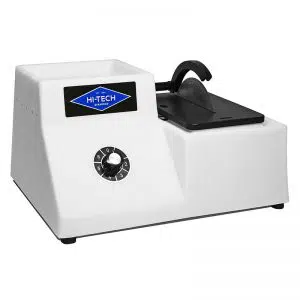
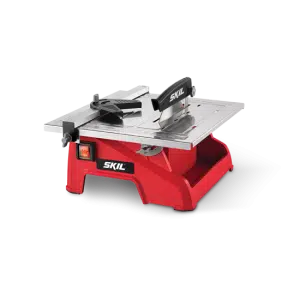
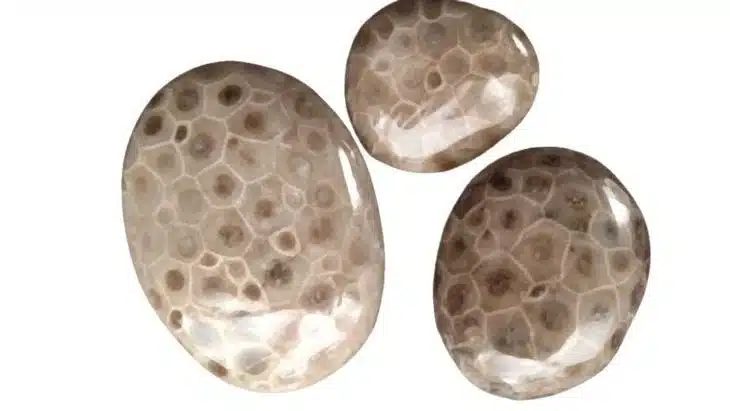
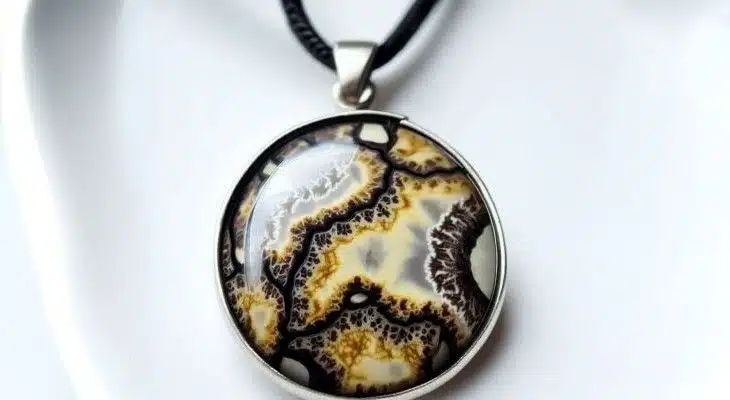


Hi John, I was looking for recommendations on which brand of glue to use for the kinds of rocks in your photo, but you didn’t list any brands of glue that could be used. The project I had in mind is very similar to the photo in your post. I would appreciate your recommendation for any brand names of glue I should buy. Thank you
Hi, Dianne. E6000 231020 Adhesive with Precision Tips will be good for your project, but read the instruction before using.